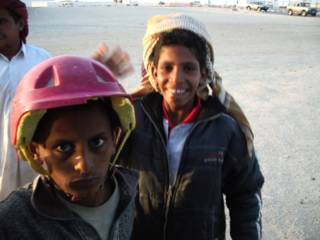Bedouin Cowboys
Qataris tend to be more receptive towards the US rather than Europe regarding modern culture and so forth. This is because they too, sense a certain similarity between themselves and Americans, many in fact, make mention of it. This is tempered though by a few things, first, there is a sense that the Gulf in general is under a cultural assault from the West. Things like “Fear Factor” and “Girls Gone Wild” come to mind. These things are known here, and utterly horrifying to Qataris. Media involving humiliation, nudity, adultery, etc are viewed as a direct attack upon traditional values, as many conservative Christians would agree. Another thing that is well known here is the American press. The US has lost a lot of credibility here based upon the slanted and self-serving media reports that have issued recently. Especially noted are the lack of concern for civilian casualties in Iraq, and the arrogant chest-beating of certain commentators. The whole Arab world is watching these bozos, and most don’t like what they see.
While Qataris aren’t crazy about certain American media, they love films and television that are family oriented. They also follow most of the toy crazes from the US, as well as Japan and Europe. They also love technology. Everybody wants to have all of the latest gadgets, and they spend huge amounts of time making creative use of them.
There is a huge dichotomy between “modern” life, represented by big, fast vehicles (white Landcruisers are by far the most common thing on the road), big modern houses full of electronic whatchamacallits, etc and traditional life. Many people have a traditional Bedouin tent set up on their property or even inside their homes. It’s sort of a reminder of who they are, and where they came from. When men go out visiting, they commonly congregate in these tents, often with a fire going. They will make Bedouin coffee (green, with cardomom) over the fire, eat dates, and talk. The arts of camel raising, falconry, swordsmanship and so forth are still alive and well.
Qatari men frequently visit each other in the evening. The visits are short, often just long enough for a couple of glasses of tea, but they are frequent. A typical night of visiting will involve several stops. News of the day is shared and discussed, and bonds of friendship affirmed. Guests are received in the majlis, a front room set aside for this purpose, or out front in a tent or raised, open porch.
Qatari men strive to entertain their guests in the most traditional way possible. If food is served, it is served on the floor, from a common dish, and eaten with the hands. The furnishings in the majlis or tent are Spartan but functional; usually a low table, a central fire pit, carpets on the floor, and “couch Arabi”. Couch Arabi is a set of cushions on the floor, set up like a series of sofas. It can be rearranged in many ways, but usually lies around the perimeter of the room. Alternatively, there may be low upholstered couches, or ornate Louis the 14th type chairs lining the walls…. sometimes thirty or more of them. The patterns for couch Arabi reflect traditional Bedouin designs and colors. Ironically, the colors… red, black, white and dark green, are based on traditional dyes that were available in the area, but all are made with modern dyes today, only the patterns remain.
Like “red state” Americans, Qataris are tied to their rural traditions. There is nothing that quite corresponds to country music here (music is often viewed with suspicion), but as country music helps reaffirm American rural culture, Qatari traditions have the same effect. In keeping their traditions alive, they are affirming their bond with their Bedouin heritage. Most folks who can, keep a place out in the country. The “country” I’m talking about looks pretty bleak… miles of rocky, flat desert scrub for the most part, except for the huge dunes of the Empty Quarter in the south. These “farms” as they are called usually have a few head of livestock and a house or shelter of some sort. Many opt for a place near the camel track, but many others, craving solitude, get a place out in the middle of nowhere.
The Bedouin still live out here too. They don’t move around anymore… that would involve crossing the border to the oases in the south, in Saudi. In order to get government benefits they must retain a fixed residence. Tents have given way to brick and mortar houses, and camels to Land Rovers (they actually still have the camels, just not as their primary mode of transport). They live either out in the country in small enclaves of one or more families, or more recently, they maintain a house in town too (there is only one town of any size in Qatar… Doha). If they have a place in town, often they choose to live in Rayyan, a suburb of Doha noted for its Bedouin traditions, and it’s horses. Rayyan was also the site of the al-Thani (royal) family’s first palace.
The Bedouin are tough and independent. They have their own system of justice, and are typically left alone by the authorities. The government seems content to let them work things out for themselves so long as they don’t cause trouble for others. Bedouins are a bit wilder and less restrained than the average Qatari. They tend to drive more aggressively (yes, it’s possible), and prefer tricked out, used, muscle cars to anything new. It’s said that Bedouins won’t drive new cars. There are some amazing old classic cars here, often with bizarre modifications. One guy in town has hundreds of shiny brass objects affixed to his old Cadillac. It looks like a speeding pin cushion.
Many folks here drive with their lights off at night. The more considerate ones at least put the parking lights on so that they can be seen. Those who drive that way claim that they can see better without lights! Of course it wouldn’t occur to them that others can’t see them. God only knows what happens when two of these guys meet going in opposite directions. I guess that this is the reason that most roads here are divided by large medians. Unnecessary risk taking is a part of the whole Bedouin tribal identity thing. Maybe young men can’t raid caravans anymore, but at least they can drive around with their lights off. Yikes!
Religion is the big cultural driving force here, and modern “culture” in the sense of mindless media displays probably doesn’t stand a chance against it in the long run. This is wahabbi country, and religion plays a larger role here than it does in most Islamic countries. Wahabbism is a simple, literalist interpretation of Islam, and it fits the Gulf mindset much like literalist Christianity fits in the American rural south. Some Americans seem to think that the Gulf will one day “outgrow” it’s religious roots, and join the “modern” world. I think that’s fantasy. If anything is ephemeral here, it is probably the fascination with western “culture”. While Qatar, and the Gulf in general, will no doubt continue to modernize, they are doing it in their own way, and at their own pace, and the roots here are probably stronger than the west realizes.









